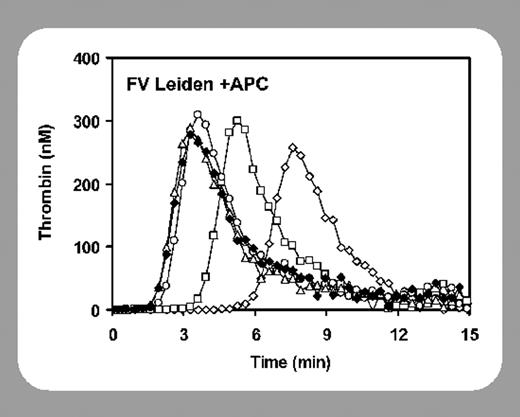HEMOSTASIS, THROMBOSIS, AND VASCULAR BIOLOGY
Since its discovery in 1943 by Paul Owren, coagulation factor V (FV) is recognized as an important procoagulant protein, its activated form (FVa) functioning as a cofactor in the generation of thrombin.1 The procoagulant activity of FVa is subjected to regulation by proteolysis mediated by activated protein C (APC), a key component of the protein C anticoagulant system.2 FV deficiency is a rare cause of bleeding problems. Much more common is the involvement of FV gene defects in the pathogenesis of venous thrombosis. A highly prevalent single point mutation in the FV gene (FVLeiden) resulting in the loss of an APC cleavage site in FV affects the regulation of FVa activity by APC. The associated phenotype is referred to as APC resistance and is characterized by a life-long hypercoagulable state and increased risk of thrombosis. During the elucidation of the pathogenesis of APC resistance, it was discovered that FV is a Janus-faced protein. Not only is it a procoagulant but it also has the capacity to function as an anticoagulant APC cofactor in the degradation of coagulation factor VIIIa (FVIIIa).2 The APC resistance associated with the FVLeiden mutation is the result of both impaired regulation of FVa by APC and loss of the anticoagulant APC cofactor activity of FV. Thus, a single point mutation in FV affects the regulation of coagulation on 2 levels: the degradations of FVIIIa and FVa. The relative importance of these 2 distinct mechanisms to the development of the hypercoagulable state that increases the risk for thrombosis has been largely unknown.
In this issue of Blood, Castoldi and colleagues (page 4173) describe methods to quantify the APC cofactor activity of FV and, moreover, they have been able to determine the relative contribution to the APC-resistance phenotype of reduced susceptibility of FVa to APC and impaired APC cofactor activity of FV. They show that FVLeiden exhibits no APC cofactor activity in FVIIIa inactivation and that APC resistance due to FVLeiden is caused by equal contributions of poor susceptibility of FVa to APC and impaired APC cofactor activity. These results are of conceptual importance and point to the involvement of the anticoagulant properties of FV in the regulation of blood coagulation. The dual effects of the FVLeiden mutation on the anticoagulant protein C system cause the increased thrombosis risk associated with this mutation. In this context it is interesting to note that mutations affecting another important APC cleavage site in FV (ie, FVCambridge [R306T] and FVHong Kong [R306G], neither of which are strong thrombosis risk factors) mainly impair the susceptibility of FVa to APC but leave the APC cofactor activity of FV virtually intact.3 In contrast, another FV gene mutation associated with thrombosis, FVLiverpool (I359T), results in the loss of the APC cofactor activity of FV.4 Additional supporting evidence for the in vivo importance of the anticoagulant APC cofactor activity of FV comes from studies of genetically modified mice.5 With these exciting results on record one might expect a renewed interest in the Janus-faced FV molecule and an intensified search for other genetic and acquired deficiencies of anticoagulant FV activity.


This feature is available to Subscribers Only
Sign In or Create an Account Close Modal